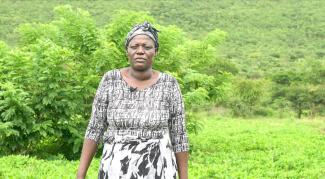Weather forecasts
Waiting for rain – and advice
 Lucas B. Mbewe
Elinat Daka in her field.
Lucas B. Mbewe
Elinat Daka in her field.
Daka grows groundnuts (also called peanuts), soybeans, maize, sunflower, cowpeas (black-eyed peas) and vegetables – all without chemical fertilisers. Her yields are comparable to those obtained with conventional farming, she says. She was inspired to use conservation farming by her cooperation with Community Markets for Conservation (COMACO), a social enterprise (see main article).
Yet her rain-fed farm faces major weather risks. Droughts and delayed rainfall can destroy crops, particularly groundnuts and soybeans. “Last year we did not get good profits from groundnuts because the crop was attacked by the rosette virus,” she says. The groundnut rosette virus is spread by sap-sucking insects called aphids. Plants that are infected early cannot be saved and will produce no yield.
The most effective prevention measure is to plant crops as soon as there is enough moisture in the soil. Farmers use a variety of signs to determine the onset of the rainy season: a proliferation of centipedes, the sprouting of specific trees or the appearance of spider webs moistened with dew. In addition, farmers receive weather forecasts via radio broadcasts and telephone apps. COMACO also provides weather updates.
These forecasts help, but do not go far enough. “The forecasts are sporadic,” Daka says. She would prefer them to be regular, and even daily and at the beginning of each rainy season.
In addition, she needs more specific, weather-related farming advice: “When they give advice, they should not only inform me about the rainfall but also tell me that I should plant late-maturing varieties if the rains are good. If it will not rain a lot, then they should tell me to plant early varieties – rather than just send a message that it will rain a lot or it will not rain a lot.”
Daka says this information would best be sent via text message, as this would create a direct link with the providers and ensure that she receives the message. Relying on extension services to send information is less reliable; sometimes the message does not get through.
Till Below works for GIZ on the Climate Risk Insurance and Information in Zambia (CRIIZ) project.
till.below@giz.de
Dina Mambwe is a lecturer in agronomy, land use, food security and climate change at the Copperbelt University, Zambia. This article reflects the co-authors’ personal opinions.
dina.mambwe@cbu.ac.zm

